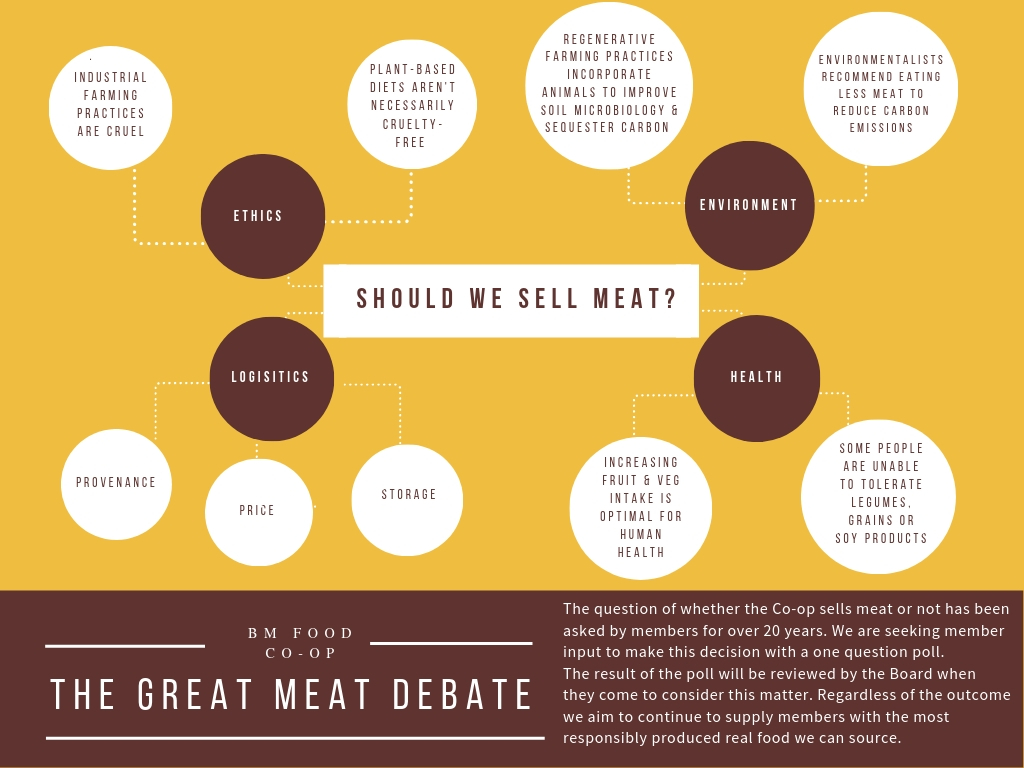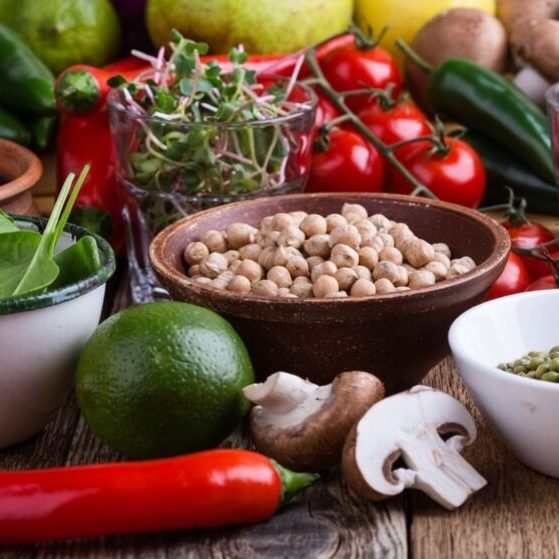

Here is a summary of information and some useful links to background reading leading up to our Meat Survey.

Environmentalists agree that adopting a plant rich-diet and eating less meat is essential to reducing future greenhouse gas emissions.

Our Soils
Since colonisation, conventional agriculture and over grazing of hard hoofed animals has caused widespread destruction to Australian soils, water systems and our native flora and fauna.[1] This is evident in our regular loss of topsoil in windstorms, water erosion, loss of soil biodiversity, loss of soil carbon, and the need for increased agricultural reliance on irrigation due to the reduced capacity of our soils to absorb water. [2]
Mono cropping and single species pasture for animal grazing has led to a loss of biodiversity of our flora and fauna and the runoff from the use of artificial fertilisers and poor management of animal waste has caused widespread water pollution.
[1] https://www.environment.gov.au/resource/threatened-australian-plants-0
[2] https://www.soilsforlife.org.au/about/why-are-soils-important.html
Greenhouse Gas Emissions
In 2017 agriculture was responsible for 13% of Australia’s greenhouse gas emissions with beef and sheep grazing responsible for two-thirds of all agricultural emissions (equaling 46 MtCO2e per year) (Australian Government 2017). “Agriculture emissions include methane and nitrous oxide produced by the digestive processes of animals (such as cattle and sheep), manure management, rice cultivation, agricultural soils and field burning of agricultural residues. It also includes carbon dioxide emissions produced by the application of fertilizers, including urea and lime.” [1]
There is indisputable evidence that in developed countries’ meat consumption needs to reduce by at least 50% of current levels in order to help reach the goal of limiting global warming to 1.5 degrees by 2030.[2]
One of the most powerful things you can do for the future health of the planet is to eat a plant rich diet.
[1] https://www.climatecouncil.org.au/wp-content/uploads/2018/06/CC_MVSA0143-Briefing-Paper-Australias-Rising-Emissions_V8-FA_Low-Res_Single-Pages3.pdf p21
[2] https://sustainabletable.org.au/all-things-ethical-eating/meat-the-issues/
Water Use
Conventional intensive livestock farming can involve many litres of water in the production of fodder for animal feed. It is often cited that it can take 15,000 litres of water to produce 1kg of beef.[1]
[1] https://waterfootprint.org/media/downloads/Report-48-WaterFootprint-AnimalProducts-Vol1_1.pdf

In contrast to conventional farming, regenerative farming practices which incorporate holistic managed grazing of ruminant animals can stimulate plant growth, improve soil microbiology, sequester carbon and improve water holding capacity.[1] Other regenerative practices include no tillage, use of multispecies cover crops, crop rotation, composting and pasture cropping.[2]
These practices can help to reverse global warming by rebuilding soil organic matter and restoring degraded soil biodiversity – resulting in both carbon drawdown and improving the water cycle.[3]
Like many other areas in the world, Australia’s current agricultural practices are rapidly leading to increasing desertification. Regenerative farming practices can help to reverse desertification and assist with providing food security in the future.[4]
[1] https://www.savory.global/impossible-impact/
[2] https://regenerationinternational.org/why-regenerative-agriculture/
[3] https://2igmzc48tf4q88z3o24qjfl8-wpengine.netdna-ssl.com/wp-content/uploads/2017/02/Regen-Ag-Definition-2.23.17-1.pdf
[4] https://www.climatecouncil.org.au/wp-content/uploads/2018/06/CC_MVSA0143-Briefing-Paper-Australias-Rising-Emissions_V8-FA_Low-Res_Single-Pages3.pdf p23
Find Out More about Regenerative Agriculture
Animal rights activists argue that there is no such thing as ethically produced meat.
WARNING: Some links in this section may be distressing.

There is no doubt that industrial farming practices are cruel[1] and don’t allow animals to express their full range of characteristics. Intensive factory farming, feedlots, sow stalls[2] and battery cages[3] restrict movement, are overcrowded, dirty and inhumane.
The reality of an omnivorous diet is that animals often suffer during their life time and die in abattoirs[4] for human consumption.
[1] https://www.dominionmovement.com/
[2] http://www.makeitpossible.com/features/sow-stall-vote.php
[3] https://www.voiceless.org.au/hot-topics/battery-hens
[4] https://www.youthfoodmovement.org.au/behind-the-scenes-at-an-australian-abattoir/

A plant-based diet isn’t necessarily cruelty free – many animals die in the production of rice, peas, legumes, fruit and other crops[1]. Farmers employ hunters or use traps to kill large numbers of native animals including possums, wallabies and ducks, as well as rodents, feral animals like deer and other bird species[2].
Mice infestations in wheat fields across the country occasion millions of deaths from poisoning annually[3].
There is also a commercial imperative at play in encouraging people to eat more processed plant-based meat alternatives[4].
[1] https://davidshoebridge.org.au/2014/08/01/200000-ducks-killed-by-amateur-hunters-in-nsw/
[2] https://www.goodfood.com.au/eat-out/news/going-meat-free-will-not-prevent-animal-suffering-says-matthew-evans-20190719-h1gd88
[3] https://www.abc.net.au/news/rural/2017-05-29/mouse-outbreak-sa-vic-plagues-grain-farmers/8567122
[4] https://www.smh.com.au/business/markets/with-the-likes-of-leonardo-dicaprio-and-bill-gates-on-board-vegan-food-company-is-set-to-make-a-wall-street-splash-20190423-p51gcd.html
Nutritionists are largely in favour of a plant-rich Mediterranean diet which includes small amounts of animal protein.

Some eating habits are known to lead to significant negative health outcomes, such as diets high in processed foods, sugar and hydrogenated vegetable oils, but the jury is still out on whether a meat-free diet or one that includes animal proteins is healthier.[1]
Most nutritionists advocate a plant-rich Mediterranean diet which includes a small amount of animal protein as one of the healthiest eating approaches. But there is also evidence to suggest that a well-balanced vegetarian diet has a number of health benefits including a reduced risk of chronic diseases like obesity, coronary artery disease, hypertension (high blood pressure), diabetes and some types of cancer.[2]
As Michael Pollan suggests: “Eat food, not too much, mostly plants.”
[1]https://eatingforyou.com.au/eat-meat-healthy/
[2] https://www.betterhealth.vic.gov.au/health/healthyliving/vegetarian-and-vegan-eating

While nutritionists and environmentalists encourage more fruit and vegetable consumption, a plant-rich diet does not exclude meat entirely. Animal products contain essential vitamins and minerals like B12, zinc, iron and Omega 3 fatty acids in easily accessible forms, while a solely plant-based diet requires a much more sophisticated understanding of food combinations with the possible addition of supplements in order to ensure access to these vitamins and minerals in sufficient usable quantities.[1]
Human beings come with a wide array of digestive systems, food tolerances and intolerances, so it makes sense that diets be as varied as possible to accommodate differing nutritional needs.
For some people digestive disorders and chronic illnesses result in an inability to tolerate the staples of a plant-based only diet – grains, legumes and soy products – and animal proteins and fats are essential for their nutrition.[2]
Some meat alternatives known colloquially as “fake meat” are highly processed and contain excessive levels of salt.[3]
[1] https://www.vegansociety.com/resources/nutrition-and-health/nutrients/vitamin-b12/what-every-vegan-should-know-about-vitamin-b12
[2] https://chriskresser.com/why-you-should-think-twice-about-vegetarian-and-vegan-diets/?__hstc=25621602.1b1e30b14137ee12148c1941c485814e.1567038506292.1568354068175.1568938460031.5&__hssc=25621602.5.1568938460031&__hsfp=3815032048&_ga=2.55850477.775972868.1568938459-1962789671.1567038504
[3] https://www.abc.net.au/news/2019-09-11/researchers-warn-of-health-dangers-of-fake-meats/11498310
We don’t have room in our current shop to sell meat on display except for perhaps bone broths in the shop fridges or packaged fish products on shelves.
If the Co-op were to sell responsibly sourced meat* it would most likely be sold on an order system and would be stored in our big coolroom across the laneway available for pick up once a week depending on availability.
Any meat sold would be slaughtered at a licensed abattoir or in a licensed on-farm facility and labelled as per the Food Standards Australia requirements.
Meat would arrived pre-packaged. There would be no repackaging or processing of meat on site.

In July 2019 we held a panel discussion on meat consumption in an effort to disseminate information on the topic. You can listen to a full recording of the event here.
All photos Canva.com